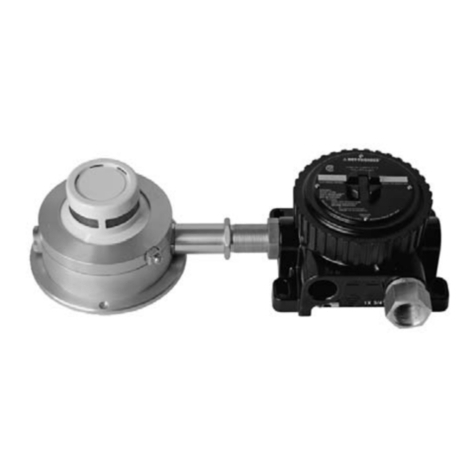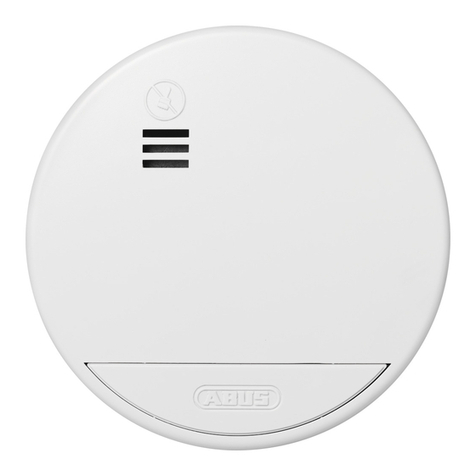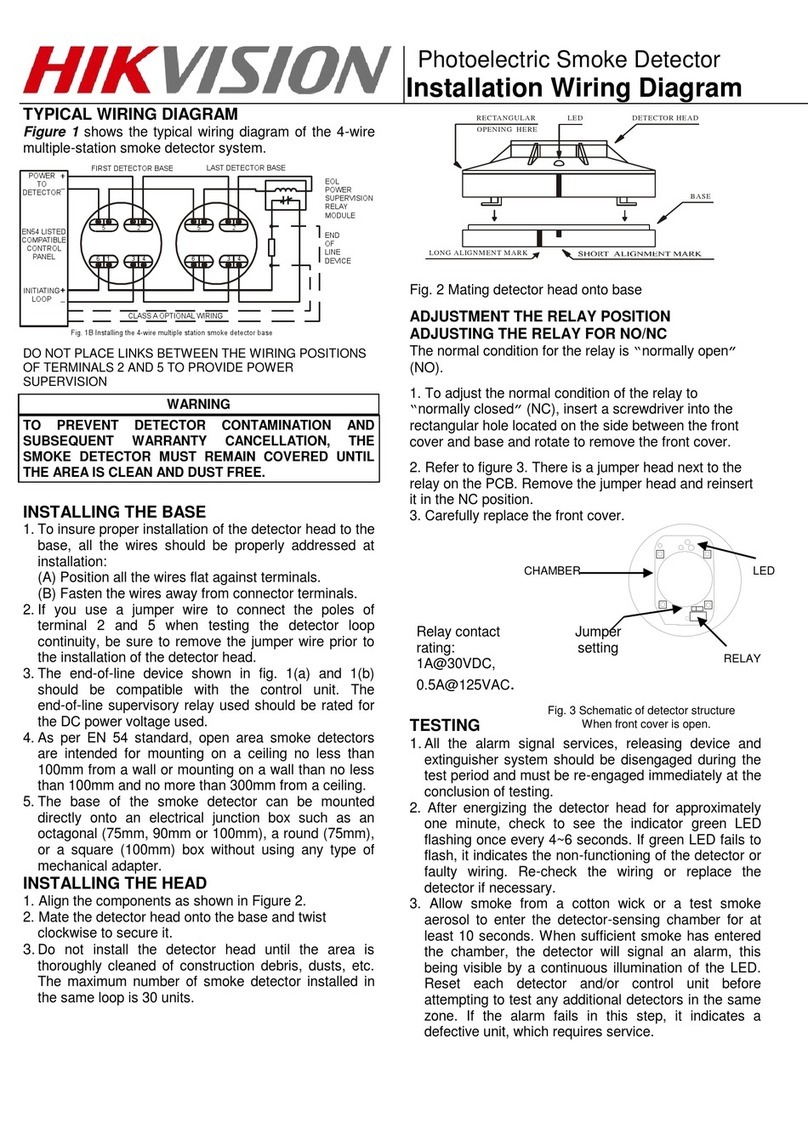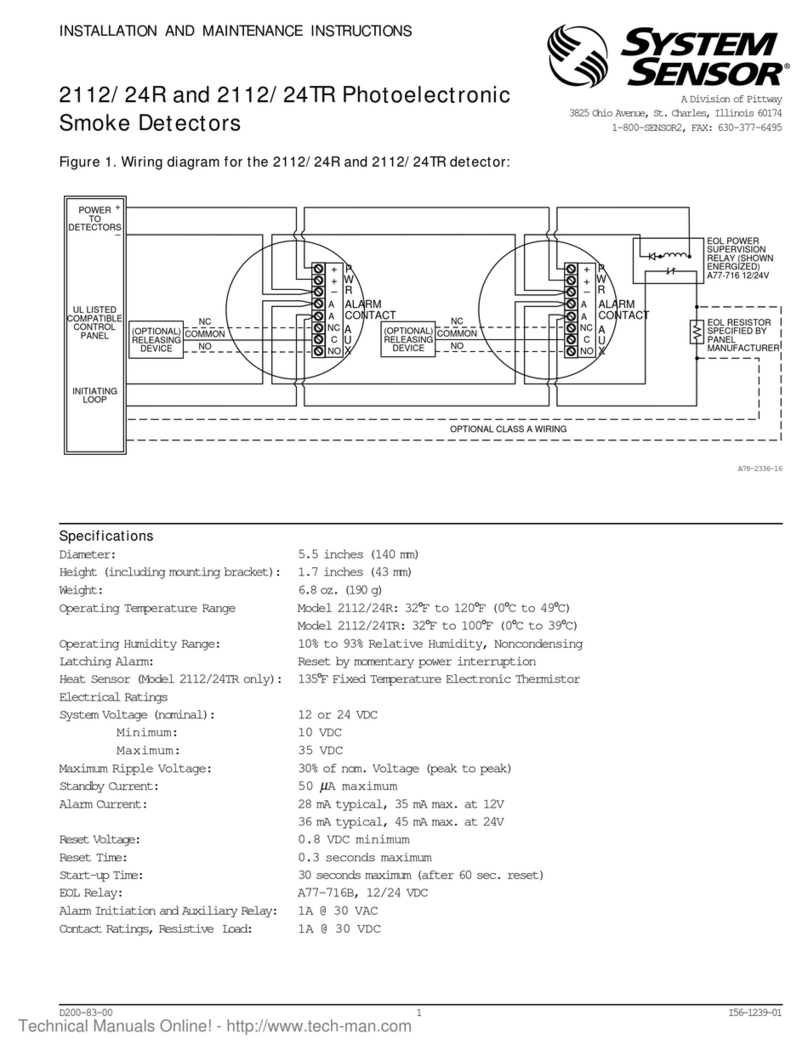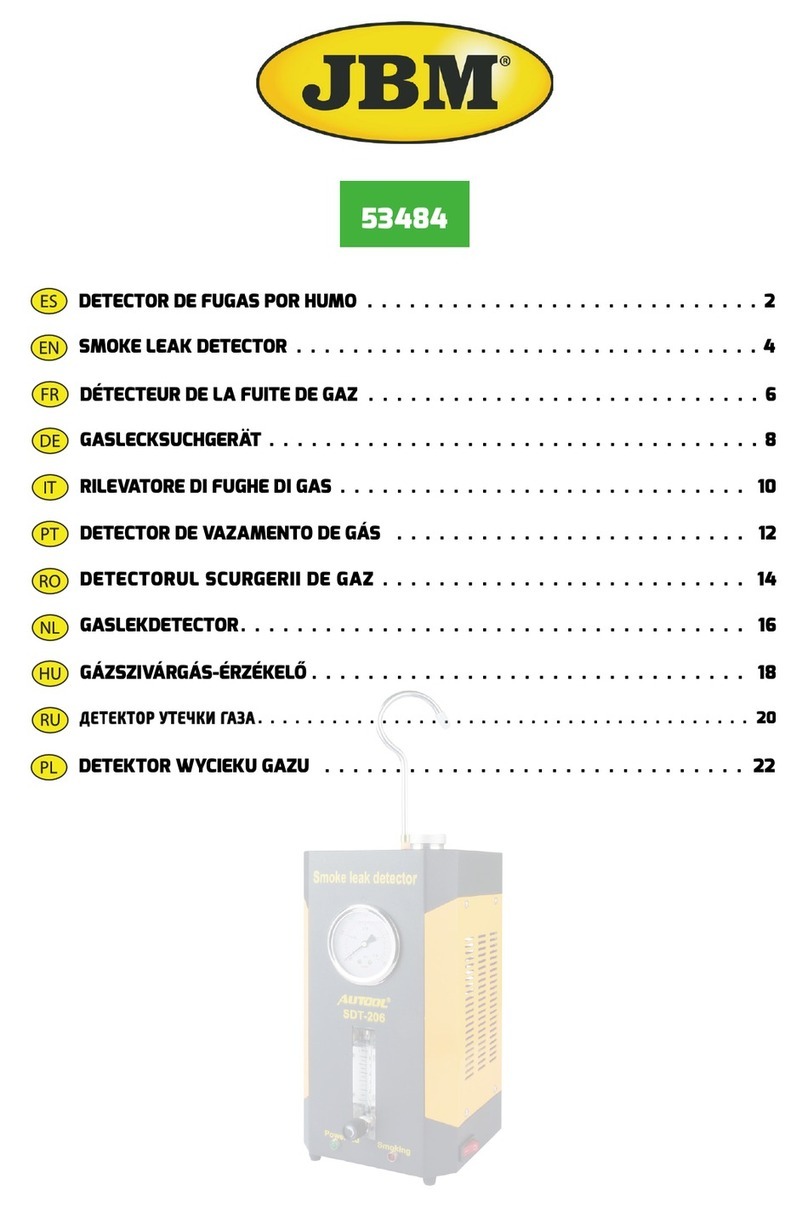Pyrotector 30-3013 User manual

3.1 Rev: 11/2020 95-8746
Instructions
Explosion Proof Smoke Detector
30-3013

Table of Contents
OVERVIEW ..........................1
FEATURES ..........................1
BENEFITS ...........................1
SPECIFICATIONS .....................2
OPERATION .........................3
Warm Up ..........................3
Outputs ...........................3
Integral Wiring Compartment ..........4
LED ..............................4
Latching...........................4
Non-Latching.......................4
Continuous Self-Test.................4
Manual Self-Test ....................4
IMPORTANT SAFETY NOTES ...........5
INSTALLATION .......................5
Grease / Lubrication .................5
Identication of Detector Mounting
Locations..........................5
Protection Against Moisture Damage....6
Power Supply Requirements ..........6
Transpor t Cover ....................6
Mounting Location Options............6
Mount the Detector ..................7
Wiring Cable Requirements ...........7
Jumper ...........................7
Wiring Procedure ...................8
MAINTENANCE .......................9
Routine Inspection ..................9
DEVICE REPAIR AND RETURN.........13
ORDERING INFORMATION ............13
Spare Parts .......................13
Accessories.......................13
30-3013 Model Matrix ...............13
APPENDIX A – FM APPROVAL
DESCRIPTION ....................14
APPENDIX B – CSA APPROVAL
DESCRIPTION ....................15
APPENDIX C – IECEx APPROVAL
DESCRIPTION ....................16

195-8746
3.1
WARNING
Be sure to read and understand the entire
instruction manual before installing or
operating the smoke detection system. Any
deviation from the recommendations in this
manual may impair system performance
and compromise safety.
OVERVIEW
The 30-3013 Explosion Proof Smoke Detector has
Division and Zone explosion-proof ratings and is
suitable for industrial and commercial applications.
The detector is designed to operate effectively with
smoldering and rapidly growing fires and contains
the ability to annunciate faults ensuring no
undisclosed failures. The 30-3013 Smoke Detector
outputs include 0-20 mA, a localized LED, and
relays.
Typical applications that use the 30-3013 include:
– Combustible storage facilities
– Munitions manufacturing
– Volatile chemical storage
– Chemical processing plants
– Petroleum refineries
– Turbine enclosures
– Battery rooms
– HVAC applications
The hot-swappable sensor module is intrinsically
safe and allows live maintenance while under
power, without de-classifying the hazardous area.
The integrated junction box is available in a
variety of port configurations for simplified wiring
and installation. See Figure 1 for all the 30-3013
Smoke Detector components.
FEATURES
• FM Approved for use in Class I, Division 1
hazardous locations
• FM Approved for smoke detection performance
• IECEx Zone approved
• Trouble-free photoelectric operation
• 0-20 mA output for DCS integration
• Self-checking circuitry ensures reliable smoke
detection
• Alarm, Auxiliary, and Fault relays for controlling
annunciating devices or fire panel interface
• LED provides a visual indication that an alarm
has occurred
• IP44 ingress protection level suitable for
onshore or offshore requirements
BENEFITS
• Ideally suited for classified areas in the
petrochemical, oil, and gas industry
• DCS, PLC, integration with milliamp or relay
outputs
• Rugged design for environmental extremes
• Visual confirmation of detector alarm
• Detects smoldering fires
• No undisclosed failures
INSTRUCTIONS
Explosion Proof Smoke Detector
30-3013
©2020 Detector Electronics Corporation Rev: 11/2020

95-8746
2
3.1
SPECIFICATIONS
OPERATING VOLTAGE—
12-30 Vdc (24 Vdc nominal)
SMOKE DENSITY—
1.5% - 2.5% obscuration per foot
(4.9% - 8.2% obscuration per meter)
POWER CONSUMPTION—
3.5 watts maximum (2.75 Watts at 24 Vdc)
0.674 Watts with no relays energized
1.23 Watts with one relay energized
2.12 Watts with two relays energized
2.68 Watts with three relays energized
OUTPUT RELAYS—
Smoke alarm relay, Form C, 5 amperes at 30 Vdc:
The smoke alarm relay has normally open/normally
closed contacts and normally de-energized
operation
Fault relay, Form A, 5 amperes at 30 Vdc:
The fault relay has normally open contacts and
normally energized operation
Auxiliary relay, Form C, 5 amperes at 30 Vdc:
The auxiliary relay has normally open/normally closed
contacts and normally de-energized operation
TEMPERATURE RANGE—
Operating: –20°C to +65°C (–4°F to +149°F)
Storage: –55°C to +70°C (–67°F to +158°F )
HUMIDITY RANGE—
5 to 95% relative humidity
INGRESS PROTECTION—
IP44
Note: Applicable to ceiling mount only
CURRENT OUTPUT—
0-20 mA (±0.3 mA) dc current, with maximum loop
resistance of 300 ohms from 12-17.9 Vdc, 500 ohms
from 18 to 19.9 Vdc, and 600 ohms from 20-30 Vdc
TERMINALS—
UL/CSA rated for 14-18 AWG or 2.5-0.75 mm2wire
THREAD OPTIONS—
3/4 inch NPT or M25
Multi-port models available
ENCLOSURE MATERIAL—
Polycarbonate / ABS - Smoke Detector
Copper-free aluminum (painted) - Junction Box
SHIPPING WEIGHT (Approximate)—
7.85 lbs (3.56 kg)
WARRANTY PERIOD—
1 year
DIMENSIONS—
See Figure 2
CERTIFICATION—
For complete approval details, refer to the appropriate
Appendix:
Figure1—30-3013 Components
I.S. SENSOR MODULE
RETAINING RING
LED
A2679
JUNCTION BOX
®

395-8746
3.1
Appendix A - FM
Appendix B - CSA
Appendix C - IECEx
OPERATION
WARM UP
When the detector is initially powered up, a warm-
up period of one – two (1-2) seconds is allotted
for internal checks and communication. During
this time, the LED is off and the current level is
3 mA. After the checks are completed, normal
operation will be indicated by the LED flashing
every four seconds (current level is 4 mA).
If the detector is unable to reach the normal
operating mode, the warm-up period may extend
to five seconds, followed by a critical fault or an
advisory fault (see Table 1 for all current levels).
If the problem persists, check for any loose wiring
connections, ensure that the voltage supply is
sufficient, and cycle power if necessary.
OUTPUTS
Relays
The 30-3013 detector is furnished with smoke
alarm, fault, and auxiliary relays. All three relays
are rated to 5 amperes at 30 Vdc.
The smoke alarm relay has a single set of
terminals and normally open / normally closed
contacts, and normally de-energized operation.
The fault relay has a single set of terminals
and normally open contacts, and normally
energized operation.
The auxiliary relay has a single set of terminals
and normally open / normally closed contacts,
and normally de-energized operation.
IMPORTANT
The auxiliary relay functions as pre-alarm.
0 to 20 mA Output
This 30-3013 provides a 0 to 20 mA dc current for
transmitting detector status information to other
devices. The circuit is wired in a non-isolated
configuration and can drive a maximum loop
resistance of 300 ohms from 12 to 17.9 Vdc, 500
ohms from 18 to 19.9 Vdc, and 600 ohms from
20 to 30 Vdc. Table 1 defines the current levels
and corresponding detector status. The output
is calibrated at the factory, with no need for field
calibration.
Figure2—30-3013 Dimensions in Inches (cm)
Table1—Detector Status Conditions Indicated by Current Level
Current
Level
(±0.3 mA)
Detector
Status
Recommended Action
0 mA Power Fault Verify 12-30 Vdc is
applied to detector
1 mA Critical
Fault
Cycle power. If fault
doe not clear or returns,
replace sensor module
or return to factory for
service.
2 mA Power
Advisory
(<12 Vdc)
Input power at detector is
<12 Vdc. Increase power
supply to 12-30 Vdc.
3 mA Warm up -
4 mA Normal -
6 mA Advisory
Fault
Cycle power. If fault
doe not clear or returns,
replace sensor module
or return to factory for
service.
16 mA Pre-Alarm Smoke present at sub-
alarm level.
20 mA Smoke
Alarm
-
4.99 (12.67)
B2680
7.55 (19.18)
2X 3.80 (9.65)
6X R0.19
2X 1.75
(4.44)
2X 2.25 (5.71)
3.75 (9.52)
4X 1.29 (3.27)
2X 2.50 (6.35)
7.55 (19.18)

95-8746
4
3.1
NOTE
The output of the 0 to 20 mA current loop
is monitored by the fault detection circuitry
of the 30-3013.Therefore, an open circuit on
the loop will cause the fault relay to change
state.
An alarm will normally override a fault, unless
the nature of the fault impairs the ability of
the detector to generate or maintain an alarm
output (i.e., loss of operating power)
INTEGRAL WIRING COMPARTMENT
All external wiring to the device is connected
within the integral junction box. The detector is
furnished with a maximum of four conduit entries,
with either 3/4 inch NPT or M25 threads.
LED
An LED, located on the detector (see Figure 1),
indicates normal operation and notifies personnel
of an alarm. Table2 indicates the condition of the
LED for each status.
LATCHING
A detector configured for latching operation will
remain in an alarm state indefinitely, after an alarm
occurs.
NON-LATCHING
A detector configured for non-latching operation
will check the alarm status of the detector once
every 10 seconds. Once smoke falls below the
alarm threshold, the alarm annunciation will clear
within 10 seconds.
IMPORTANT
The latching or non-latching conguration
must be specied during order placement.
It is not eld congurable.
Only the alarm annunciation can be
congured for latching operation.
CONTINUOUS SELF-TEST
During normal operation, the detector performs
the Self-Test function automatically in the
background once per second. During the test,
detection is not interrupted and no indication is
given if the test passed. If the test fails, a critical
fault will occur. If degradation is present and
approaching critical levels, an advisory fault will
occur.
MANUAL SELF-TEST
The Manual Self-Test function will immediately
check the smoke chamber optics for degradation.
Once initiated, there will be a one second delay
before the result of the check is active. If there is a
failure, the LED will shut off immediately after the
one second test and a critical fault will occur. If the
test passes, an alarm will be annunciated while
the LED remains active.
For a latching detector, the alarm will continue
until power is cycled to the unit. For a non-latching
detector the alarm will clear after 10 seconds. If
the test passes, but there is degradation present
and approaching critical levels, an advisory fault
will occur.
Magnetic Switch
The magnetic switch is used to initiate the Manual
Self-Test (see Figure 3). Apply the magnet to the
exterior housing and the LED will light to indicate
that the magnet is detected. The LED will remain
lit for at least one second during the test. After
the initial delay, the test status will be indicated as
described in the "Manual Self-Test" section.
Table2—Detector Status Indicator
Detector Status LED Indicator
Power On /
Normal Operation
Steady Off
1 blink on every 4 seconds
Alarm Steady On
Figure3—Location of Magnetic Switch
MAGNETIC SWITCH

595-8746
3.1
IMPORTANT SAFETY NOTES
CAUTION
The wiring procedures in this manual are
intended to ensure proper functioning of the
device under normal conditions. However,
because of the many variations in wiring
codes and regulations, total compliance to
these ordinances cannot be guaranteed.
Be certain that all wiring complies with the
NEC as well as all local codes. If in doubt,
consult the authority having jurisdiction
before wiring the system. Installation must
be done by a properly trained person.
CAUTION
This product has been tested and approved
for use in hazardous areas. However, it must
be properly installed and used only under
the conditions specied within this manual
and the specic approval certicates. Any
device modication, improper installation, or
use in a faulty or incomplete conguration
will render warranty and product
certications invalid.
CAUTION
The device contains no user serviceable
components. Service or repair should
never be attempted by the user. Device
repair should be performed only by the
manufacturer.
CAUTION
The 30-3013 is to be installed in locations
where the risk of mechanical damage is low.
LIABILITIES
The manufacturer’s warranty for this
product is void, and all liability for proper
function of the detector is irrevocably
transferred to the owner or operator in the
event that the device is serviced or repaired
by personnel not employed or authorized
by Detector Electronics Corporation,
or if the device is used in a manner not
conforming to its intended use.
NOTE
Observe precautions for handling
electrostatic sensitive devices.
The 30-3013 should not be installed in
areas in which ammonia, hydrogen sulde
and chlorine are normally present.
INSTALLATION
WARNING
All entries must contain appropriately rated
plugs or fittings. It is required that each
plug or fitting be wrench-tightened to an
appropriate installation torque and meet the
minimum thread engagement requirements
per the applicable local standards, codes,
and practices in order to retain the dened
ratings. PTFE sealant or equivalent should
be used on NPT threads.
NOTE
Detector housings must be electrically
connected to earth ground. Internal
and external earth ground terminals are
provided. For AEx (United States Zone)
installations the internal ground terminal
shall be used for the equipment grounding
connection. The external terminal can be
used for supplementary bonding where
local codes permit or require.
NOTE
The 30-3013 detector uses an internal
Intrinsically Safe (I.S.) Barrier. Proper NEC
I.S. grounding must be ensured.
GREASE/LUBRICATION
To ease installation and future removal, all
threaded covers, stopping plugs, and thread
adapters must be installed using thread lubricant.
The recommended lubricant is a silicone-free
grease, available from Det-Tronics.
For devices with NPT threads, Teflon tape or
thread seal lubricant must be used for enhanced
sealing capabilities.
IDENTIFICATION OF DETECTOR MOUNTING
LOCATIONS
The most effective number and placement of
detectors varies depending on the conditions on
site. The individual designing the installation must
often rely on experience and sound judgment
to determine the detector quantity and best
locations to adequately protect the area. Note that
it is typically advantageous to locate detectors
where they are accessible for maintenance.
For additional information on detector location
and spacing, visit the National Fire Protection
Association's website (www.nfpa.org) and refer to
the National Fire Alarm and Signaling Code, NFPA
72, the standard on automatic fire detectors, or
your local codes and standards.

95-8746
6
3.1
PROTECTION AGAINST MOISTURE DAMAGE
It is important to take proper precautions during
installation to ensure that moisture will not come
in contact with the electrical connections of the
system. The integrity of the system regarding
moisture protection must be maintained for
proper operation and is the responsibility of the
installer.
If conduit is used, the use of proper conduit
installation techniques, breathers, glands, and
seals is required to prevent water ingress and/or
maintain the explosion-proof rating.
Conduit drains must be installed at water
collection points to automatically drain
accumulated moisture. Conduit breathers
should be installed at upper locations to
provide ventilation and allow water vapor to
escape. At least one breather should be used
with each drain.
Conduit raceways should be inclined so that
water will flow to low points for drainage and
will not collect inside enclosures or on conduit
seals. If this is not possible, install conduit drains
above the seals to prevent the collection of water
or install a drain loop below the detector with a
conduit drain at the lowest point of the loop.
POWER SUPPLY REQUIREMENTS
Calculate the total detection system power
consumption rate in watts from cold start-up.
Select a power supply with adequate capability
for the calculated load. Ensure that the selected
power supply provides sufficient regulated and
filtered output power for the entire system. If a
back-up power system is required, a float-type
battery charging system is recommended. If an
existing source of power is being used, verify
that system requirements are met.
TRANSPORT COVER
The Transport Cover (see Figure 4) keeps dust
and particles out of the smoke chamber that may
enter during transport, handling, or installation. It
should remain fastened on the detector through
the installation process.
IMPORTANT
Remove the cover only after installation
is complete and prior to powering the
detector for the rst time.
MOUNTING LOCATION OPTIONS
Ceiling Mount
The 30-3013 is intended for surface mounting. It
is normally mounted on the ceiling no less than six
inches from a side wall (See Figure 5). The exact
location of the detector must be determined by an
evaluation based on engineering judgement, or if
possible, by field tests.
Wall Mount
The 30-3013 can also be mounted on a side wall
(see Figure 6). The exact location of the detector
must be determined by an evaluation based
on supplemented engineering judgement, or if
possible, by field tests.
IMPORTANT
Whenever possible, select a mounting
orientation where the LED is visible to
personnel within the area.
Figure4—30-3013 Transport Cover
TRANSPORT
COVER
Figure5—30-3013 Ceiling Mount
6” Minimum
CEILING
LED
NOTE: MAKE CERTAIN THAT THE LED
IS POSITIONED WHERE VISIBLE.
SIDE
WALL
A2681

795-8746
3.1
MOUNT THE DETECTOR
Using three No. 8 flat head screws (or equivalent)
placed through the counter bored holes in the
detector flange, secure the detector junction box
to the surface location.
WIRING CABLE REQUIREMENTS
Always use proper temperature rated cabling
type and diameter for input power as well as
output signal wiring. 14 to 18 AWG (.75 - 2.5 mm2)
shielded stranded copper wire is recommended.
The field wiring terminal connections are
certified for a single wire in size from 12-24 AWG
(0.2 to 2.5 mm2or two conductors with same
cross section 0.2 to 0.75 mm2). The screws must
be tightened down with a torque 4.4 - 5.3 in-
lb (0.4 to 0.5 Nm). The metal housing must be
electrically connected to earth ground.
A minimum of 12 Vdc must be present at the 30-
3013 to ensure proper operation. The maximum
cable length from power source to 30-3013 is 2000
feet (610 m). When the 30-3013 Smoke Detector is
mounted remotely using an STB termination box,
maximum cable length from 30-3013 to STB is 500
feet (150 m).
WARNING
For eld connections, use wires/cables that
are rated at 20°C greater than the maximum
ambient temperature.
NOTE
In applications where the wiring is
installed in conduit, dedicated conduit is
recommended. Avoid low frequency, high
voltage, and non-signaling conductors to
prevent nuisance EMI problems.
JUMPER
Depending on the wiring option that is used,
jumpers may be required. See Table 3 for the
Jumper Usage Guide, and Figures 12 to 15 for
wiring examples.
Figure6—30-3013 Wall Mount
CEILING
SIDE
WALL
6” Minimum
LED
NOTE: MAKE CERTAIN THAT THE LED
IS POSITIONED WHERE VISIBLE.
A2682
Table3—Jumper Usage Guide
Wiring
Option 0-20 mA Relay
1 Used No jumper
required Not
Used No jumper
required
2 Used No jumper
required Used
Jumper
required in
terminals 7 &
4 (P5)
3Not
Used
Jumper
required in
terminals 5 &
4 (P11)
Used
Jumper
required in
terminals 7 &
4 (P5)

95-8746
8
3.1
WIRING PROCEDURE
Ensure that all cables are terminated properly.
Conductor insulation should be stripped off with a
bare conductor length of 0.28 inch (7 mm). Ensure
that cable shield is properly terminated and that
bare shield wire is not allowed to accidentally
contact the metal housing or any other wire.
Use the following instructions when wiring the 30-
3013 detector:
1. Slightly loosen the three setscrews located
on the retaining ring (see Figure 7).
2. Unscrew the retaining ring to gain access
to the wiring terminals (see Figure 8), and
complete the installation of the system
conduit. Feed the external wiring through
the remaining junction box entry or M25
to 3/4 inch adapter. When installing the
junction box, use care not to damage the
wires and refrain from twisting them.
3. Connect the external wiring to the
appropriate terminals.
– Figure 9 shows the wiring terminals.
– Figure 10 shows the ground lug
locations.
– Figures 12 and 13 show wiring for single
detector configurations.
– Figures 14 and 15 show wiring for multiple
detector configurations.
4. Re-install the assembly. Use the alignment
guide (see Figure 11) to align the retaining
ring with the junction box.
5. Screw the retaining ring on to the junction
box and re-tighten the three setscrews.
RELAY
OUTPUTS
A2683
– mA
– Vin
+ Vin
– Vin
+ Vin
5
4
3
2
1
POWER
SUPPLY &
0-20 mA OUTPUT
P11
P5
NO AUX
COM AUX
NC AUX
NO ALARM
COM ALARM
NC ALARM
COM FAULT
NO FAULT
1
2
3
4
5
6
7
8
Figure7—Setscrew Location
SET SCREWS (3)
RETAINING RING
Figure9—30-3013 Wiring Terminals
Figure8—Location of Wiring Terminals
RETAINING RING
WIRING
TERMINALS

995-8746
3.1
GROUND LUGS
ALIGNMENT GUIDE
MAINTENANCE
WARNING
To avoid a potential electrostatic discharge
(ESD), do not wipe or rub the surface of the
30-3013 sensor module.
NOTE
The 30-3013 Smoke Detector contains no
user serviceable components and should
never be opened. The 30-3013 wiring
compartment is the only part of the smoke
detector that should be opened by the user
in the eld.
ROUTINE INSPECTION
Regularly scheduled maintenance is not
required, however, the 30-3013 cover and smoke
chamber should be inspected periodically when
detectors are located in abnormally dirty or dusty
environments, to ensure the smoke chamber is
not blocked by dirt or debris.
The smoke detector can be tested using the
same methods employed for any photo-electric
detector. Det-Tronics recommends using a
test aerosol smoke dispenser for periodic
maintenance of the detector.
Figure10—Ground Lug Locations
Figure11—Alignment Guide Location

95-8746
10
3.1
POWER
2 WIRE
CLASS B
RECEIVING ZONE
CHASSIS
GROUND
–
+
–
+
GROUND LUG
B2684
Control Panel
600 Ω MAX
AT 24 VDC
mA
RELAY
OUTPUTS
– mA
– Vin
+ Vin
– Vin
+ Vin
5
4
3
2
1
POWER
SUPPLY &
0-20 mA OUTPUT
P11
P5
NO AUX
COM AUX
NC AUX
NO ALARM
COM ALARM
NC ALARM
COM FAULT
NO FAULT
1
2
3
4
5
6
7
8
Figure12—Single Detector Wiring (0-20 mA used, Relays not used)
POWER
2 WIRE
CLASS B
RECEIVING ZONE
CHASSIS
GROUND
–
+
GROUND LUG
B2685
Control Panel
JUMPERS
EOL
RESISTOR
RELAY
OUTPUTS
– mA
– Vin
+ Vin
– Vin
+ Vin
5
4
3
2
1
POWER
SUPPLY &
0-20 mA OUTPUT
P11
P5
NO AUX
COM AUX
NC AUX
NO ALARM
COM ALARM
NC ALARM
COM FAULT
NO FAULT
1
2
3
4
5
6
7
8
Figure13—Single Detector Wiring (0-20 mA not used, Relays used)

11 95-8746
3.1
POWER
2 WIRE
CLASS B
RECEIVING ZONE
CHASSIS
GROUND
GROUND LUG
–
+
B2686
Control Panel
mA
–
+
600 Ω MAX
AT 24 VDC
mA
–
+
600 Ω MAX
AT 24 VDC
mA
–
+
600 Ω MAX
AT 24 VDC
FIRST DETECTOR IN LOOPLAST DETECTOR IN LOOP
RELAY
OUTPUTS
– mA
– Vin
+ Vin
– Vin
+ Vin
5
4
3
2
1
POWER
SUPPLY &
0-20 mA
OUTPUT
P11
P5
NO AUX
COM AUX
NC AUX
NO ALARM
COM ALARM
NC ALARM
COM FAULT
NO FAULT
1
2
3
4
5
6
7
8
RELAY
OUTPUTS
– mA
– Vin
+ Vin
– Vin
+ Vin
5
4
3
2
1
POWER
SUPPLY &
0-20 mA
OUTPUT
P11
P5
NO AUX
COM AUX
NC AUX
NO ALARM
COM ALARM
NC ALARM
COM FAULT
NO FAULT
1
2
3
4
5
6
7
8
RELAY
OUTPUTS
– mA
– Vin
+ Vin
– Vin
+ Vin
5
4
3
2
1
POWER
SUPPLY &
0-20 mA
OUTPUT
P11
P5
NO AUX
COM AUX
NC AUX
NO ALARM
COM ALARM
NC ALARM
COM FAULT
NO FAULT
1
2
3
4
5
6
7
8
Figure14—Multiple Detector Wiring (0-20 mA used, Relays not used)

95-8746
12
3.1
POWER
2 WIRE
CLASS B
RECEIVING ZONE
CHASSIS
GROUND
GROUND LUG
–
+
B2687
Control Panel
FIRST DETECTOR IN LOOPLAST DETECTOR IN LOOP
JUMPER
JUMPERJUMPER
JUMPER
EOL
RESISTOR
RELAY
OUTPUTS
– mA
– Vin
+ Vin
– Vin
+ Vin
5
4
3
2
1
POWER
SUPPLY &
0-20 mA
OUTPUT
P11
P5
NO AUX
COM AUX
NC AUX
NO ALARM
COM ALARM
NC ALARM
COM FAULT
NO FAULT
1
2
3
4
5
6
7
8
RELAY
OUTPUTS
– mA
– Vin
+ Vin
– Vin
+ Vin
5
4
3
2
1
POWER
SUPPLY &
0-20 mA
OUTPUT
P11
P5
NO AUX
COM AUX
NC AUX
NO ALARM
COM ALARM
NC ALARM
COM FAULT
NO FAULT
1
2
3
4
5
6
7
8
RELAY
OUTPUTS
– mA
– Vin
+ Vin
– Vin
+ Vin
5
4
3
2
1
POWER
SUPPLY &
0-20 mA
OUTPUT
P11
P5
NO AUX
COM AUX
NC AUX
NO ALARM
COM ALARM
NC ALARM
COM FAULT
NO FAULT
1
2
3
4
5
6
7
8
Figure15—Multiple Detector Wiring (0-20 mA not used, Relays used)

13 95-8746
3.1
DEVICE REPAIR AND RETURN
The detector is not designed to be repaired in
the field. If it is determined that the problem is
caused by an electronic defect, the device must
be returned to the factory for repair. The sensor
module is field replaceable in case of dirtiness,
damage, or failures incurred in the field.
Prior to returning devices, contact the nearest
local Det-Tronics office so that a Return
Material Authorization (RMA) number can be
assigned. A written statement describing the
malfunction must accompany the returned
device or component to assist and expedite
finding the root cause of the failure.
Pack the unit properly. Always use sufficient
packing material. Where applicable, use an
antistatic bag as protection from electrostatic
discharge.
NOTE
Det-Tronics reserves the right to apply a
service charge for repairing returned
product damaged as a result of improper
packaging.
Return all equipment transportation prepaid to
the factory in Minneapolis.
ORDERING INFORMATION
When ordering, please specify:
30-3013 Explosion Proof Smoke Detector
Refer to the 30-3013 Model Matrix for details.
For assistance in ordering a system to fit your
application, please contact:
Detector Electronics Corporation
6901 West 110th Street
Minneapolis, Minnesota 55438 USA
Operator: (952) 941-5665 or (800) 765-FIRE
Customer Service: (952) 946-6491
Fax: (952) 829-8750
Web site: www.det-tronics.com
E-mail: det-tronics@carrier.com
SPARE PARTS
30-3013 Replacement Sensor Module
104286-001
ACCESSORIES
Canned Smoke 000119-008
000119-046
Grease (silicone-free) 005003-001
Magnet
102740-002
Magnet with Extension Pole
007739-001
Stop Plug, 3/4" NPT, AL
101197-001
Stop Plug, M25, AL
101197-005
Q3013D-1 Duct Mount w/1 ft. tube 012894-001
Q3013D-1 Duct Mount w/3 ft. tube 012894-003
Q3013D-1 Duct Mount w/6 ft. tube 012894-006
Q3013D-1 Duct Mt. w/10 ft. tube 012894-010
30-3013 MODEL MATRIX
MODEL DESCRIPTION
30-3013 Explosion Proof Smoke Detector
TYPE MATERIAL
AAluminum
TYPE PORT
11 Port
22 Port
33 Port
44 Port
TYPE THREAD
MMetric M25
N3/4" NPT
TYPE OUTPUT
12 0-20 mA, Relay, Non-Latching
13 0-20 mA, Relay, Latching
TYPE APPROVAL
AFM/IECEx/CSA

95-8746
14
3.1
APPENDIX A
FM APPROVAL DESCRIPTION
Applicable Documents:
FM 3810: 2005 Elec. and Electronic Test, Measuring, and Process Control Equipment
FM 3600: 2011 Electrical Equipment for use in Hazardous (Classified) Locations
FM 3610: 2010 Intrinsically Safe, Class I, II, III, Div I, Haz. Loc.
FM 3611: 2004 Elec. Equip. for use in Cl. I/II, Div. 2 and Cl. III, Div. 1/2 Haz. Loc.
FM 3615: 2006 Explosion proof Electrical Equipment
FM 3230: 2010 Smoke actuated detectors for automatic alarm signaling
ANSI/ISA 1010-1: 2004 Safety Requirements for Electrical Equipment for Measurement,
Control, and Laboratory Use – Part 1: General Requirements
ANSI/IEC 60529: 2004 Degrees of Protection Provided by Enclosures (IP Code)
ANSI/ISA 60079-0: 2013 Explosive atmospheres – Part 0: Equipment – General Requirements
ANSI/ISA 60079-1: 2013 Explosive atmospheres – Part 1: Equipment protection by Flameproof
Enclosures “d”
ANSI/ISA 60079-11: 2014 Explosive atmospheres – Part 11: Equipment protection by intrinsic
safety “i"
Special Conditions For Safe Use X:
1. The 30-3013 is to be installed in locations where the risk of mechanical damage is low.
2. Potential electrostatic charging hazard please see instructions for proper installation.
3. All unused device openings must be closed using a suitably certified plug.
4. For field connections, use wire rated 20°C greater than maximum ambient temperature.
5. For AEx d rated Model 30-3013 Smoke Detector, the flameproof joints are not allowed to be
repaired per manufacturer's instruction manual.
6. The 30-3013 shall be used with the Q3013D Duct Mount Accessory for duct mount
installations.
30-3013
Class I Div 1 Groups B, C, D T4
Class I Div 2 Groups A, B, C, D T4
Class I Zone 1 AEX db ia IIC T4 Gb
Tamb –20°C to +65°C
IP44
Q3013D Duct Mount Accessory
ANSI/UL 268A: 4th Edition Standard for Smoke Detectors for Duct Applications (only when
installed on the vertical surface of the duct)

15 95-8746
3.1
APPENDIX B
CSA APPROVAL DESCRIPTION
30-3013
Class - C481804 - Signal Appliances - Systems - For Hazardous Locations
Ex db ia IIC T4 IP44
Applicable Requirements
C22.2 No. 0-M91 General requirements - Canadian Electrical Code, Part II
C22.2 No. 60529: 2015 Degrees of protection provided by enclosures (IP Code).
C22.2 No. 610101-1: 2012 Safety requirements for electrical equipment for measurement, control,
and laboratory use - Part 1: General Requirements.
C22.2 No. 60079-0: 2015 Electrical apparatus for explosive gas atmospheres - Part 0: General
Requirements
C22.2 No. 60079-1: 2016 Explosive atmospheres - Part 1: Equipment protection by flameproof
enclosures "d".
C22.2 No. 60079-11: 2014 Electrical apparatus for explosive gas atmospheres - Part 11: Intrinsic
Safety "i".
Special Conditions For Safe Use X:
1. Field wiring must be in accordance with CEC Part 1, Section 18.
2. The enclosure must be bonded to ground according to CEC Part 1, Section 18.
3. For enclosures with metric conduit entries certified metric to NPT adaptors shall be used.
4. All unused openings must be closed using suitably certified plugs.
5. A seal shall be installed within 18" of enclosure.
6. Measures must be taken to avoid ignition due to mechanical impact.
7. IPx4 maintained only when mounted on a ceiling.

16 95-8746
3.1
APPENDIX C
IECEx APPROVAL DESCRIPTION
30-3013
IECEx FMG15.0014X
Ex db ia IIC T4 Gb
Tamb –20°C to +65°C
IP44
IEC Standards:
IEC 60079-0:2011 Electrical apparatus for explosive atmospheres, General Requirements
IEC 60079-1:2014 Electrical apparatus for explosive atmospheres, Flameproof enclosure "d"
IEC 60079-11:2011 Intrinsic Safety explosive atmospheres Equip protection by Intrinsic Safety
Special Conditions For Safe Use X:
1. The 30-3013 is to be installed in locations where the risk of mechanical damage is low.
2. Potential electrostatic charging hazard please see instructions for proper installation.
3. All unused device openings must be closed using a suitably certified plug.
4. For field connections, use wire rated 20°C greater than maximum ambient temperature.
5. For Ex d rated Model 30-3013 Smoke Detector, the flameproof joints are not allowed to be
repaired per manufacturer's instruction manual.

95-8746
17
3.1
This page intentionally left blank

95-8746
Corporate Office
6901 West 110th Street
Minneapolis, MN 55438 USA
www.det-tronics.com
All trademarks are the property of their respective owners.
© 2020 Carrier. All rights Reserved.
Det-Tronics manufacturing system is certified to ISO 9001— the
world’s most recognized quality management standard.
Phone: 952.941.5665
Toll-free: 800.765.3473
Fax: 952.829.8750
det-t[email protected]
Table of contents
Other Pyrotector Smoke Alarm manuals
Popular Smoke Alarm manuals by other brands
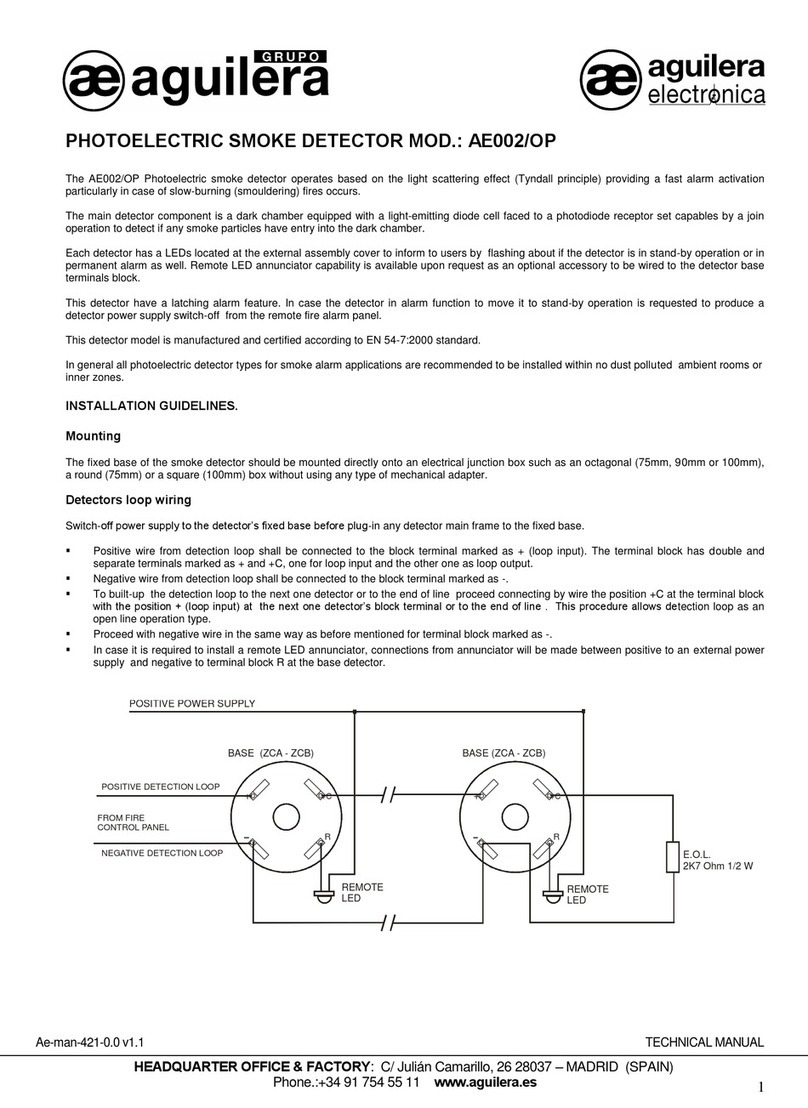
aguilera electronica
aguilera electronica AE002/OP Technical manual

UniPOS
UniPOS FD 7130 instruction manual
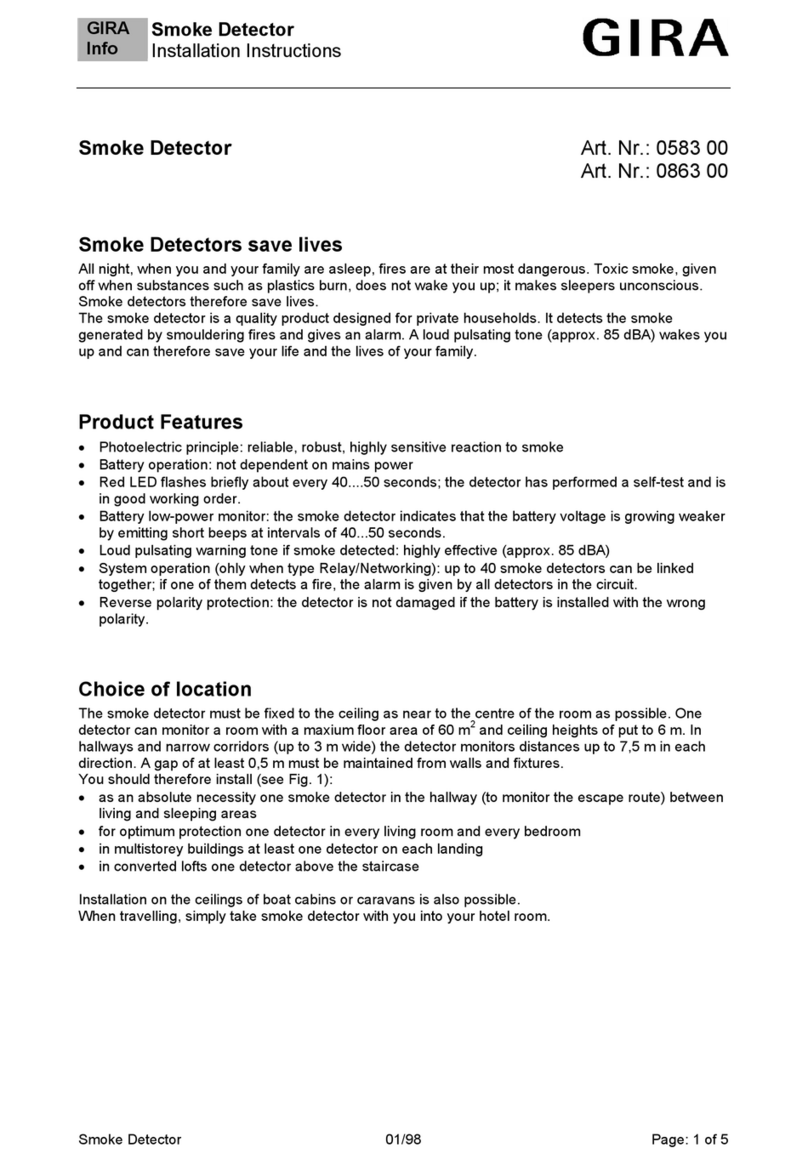
Gira
Gira smoke detector installation instructions
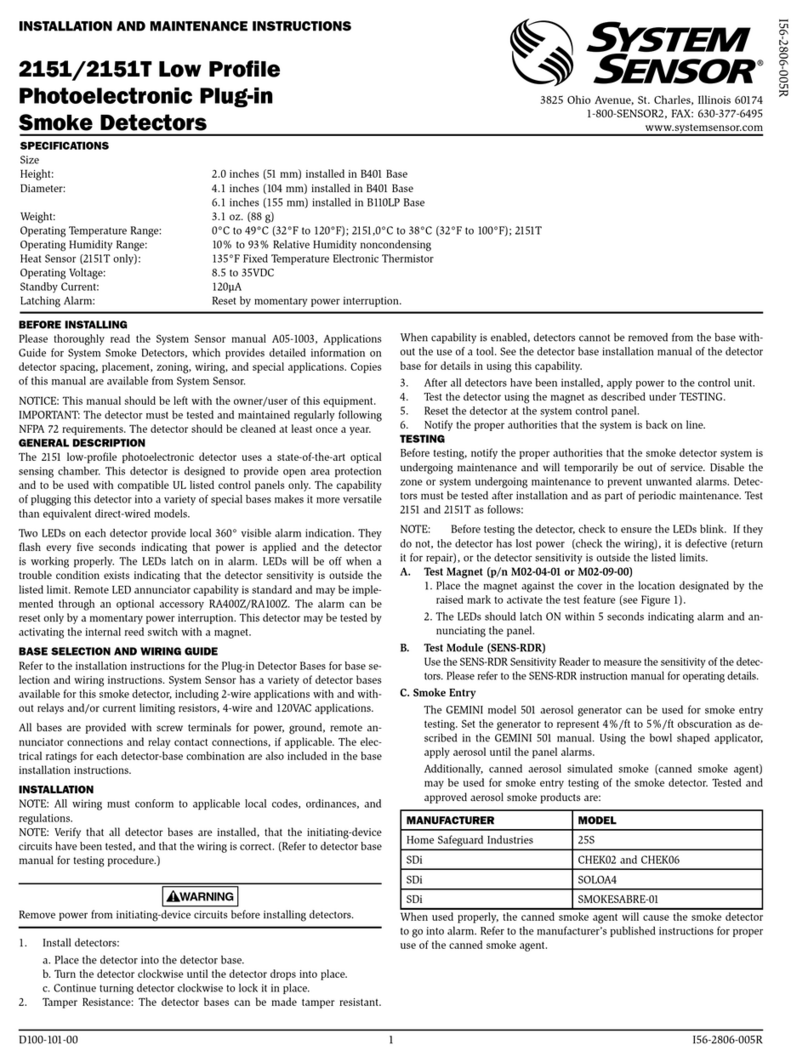
System Sensor
System Sensor 2151 Installation and maintenance instructions
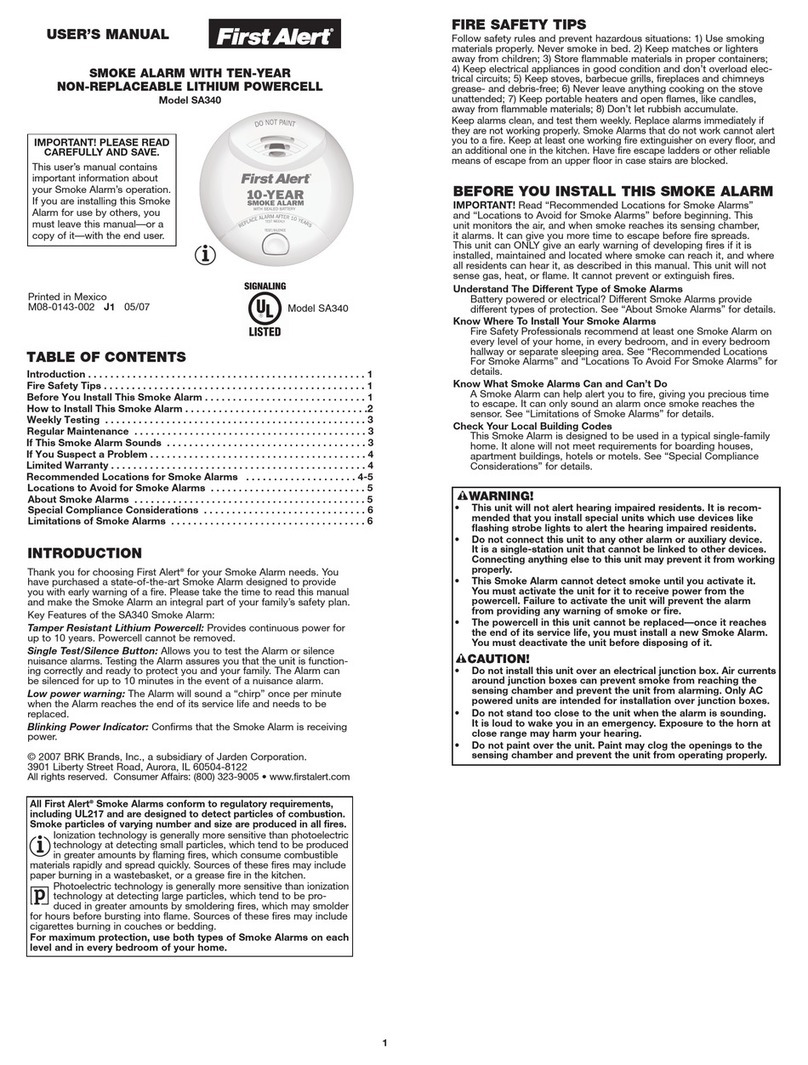
First Alert
First Alert SA340 user manual

FAAST
FAAST XS 7100X Comprehensive user's guide

Bosch
Bosch FERION 1000 O user guide
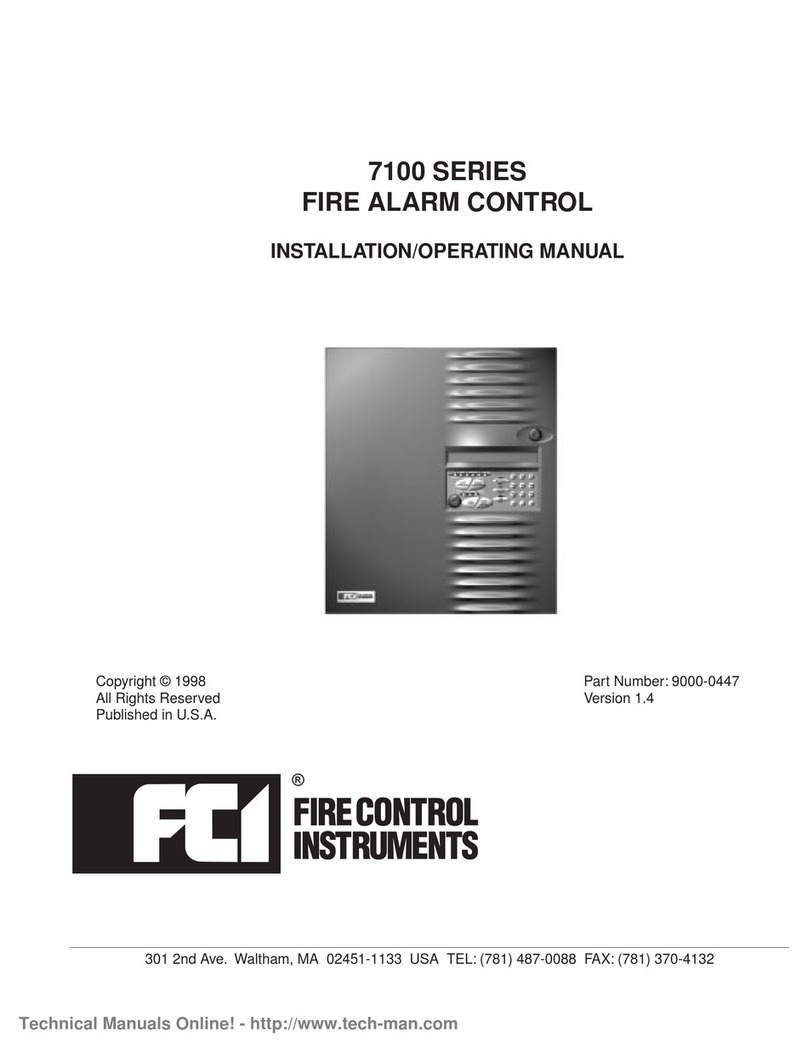
FCI
FCI 7100 SERIES Installation & operating manual
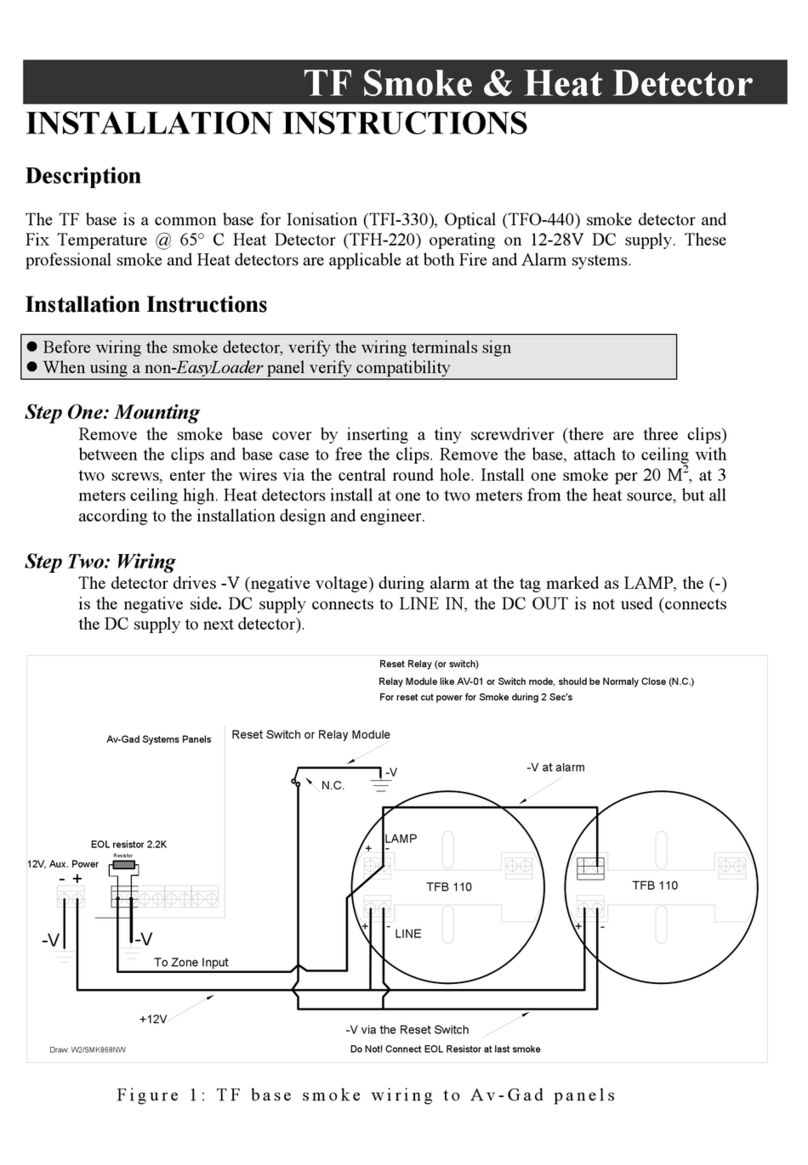
AV-GAD
AV-GAD TFI-330 installation instructions
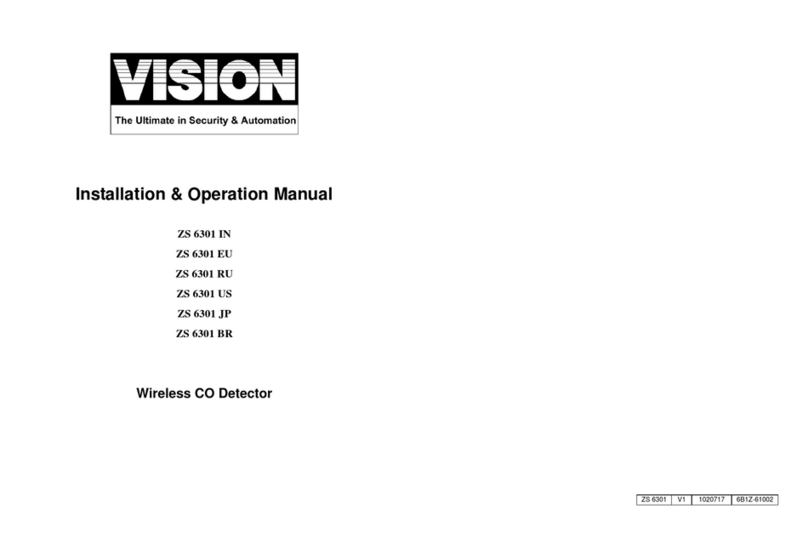
Vision
Vision ZS 6301 IN Installation & operation manual

Fire-Lite
Fire-Lite CP355 Installation and maintenance instructions
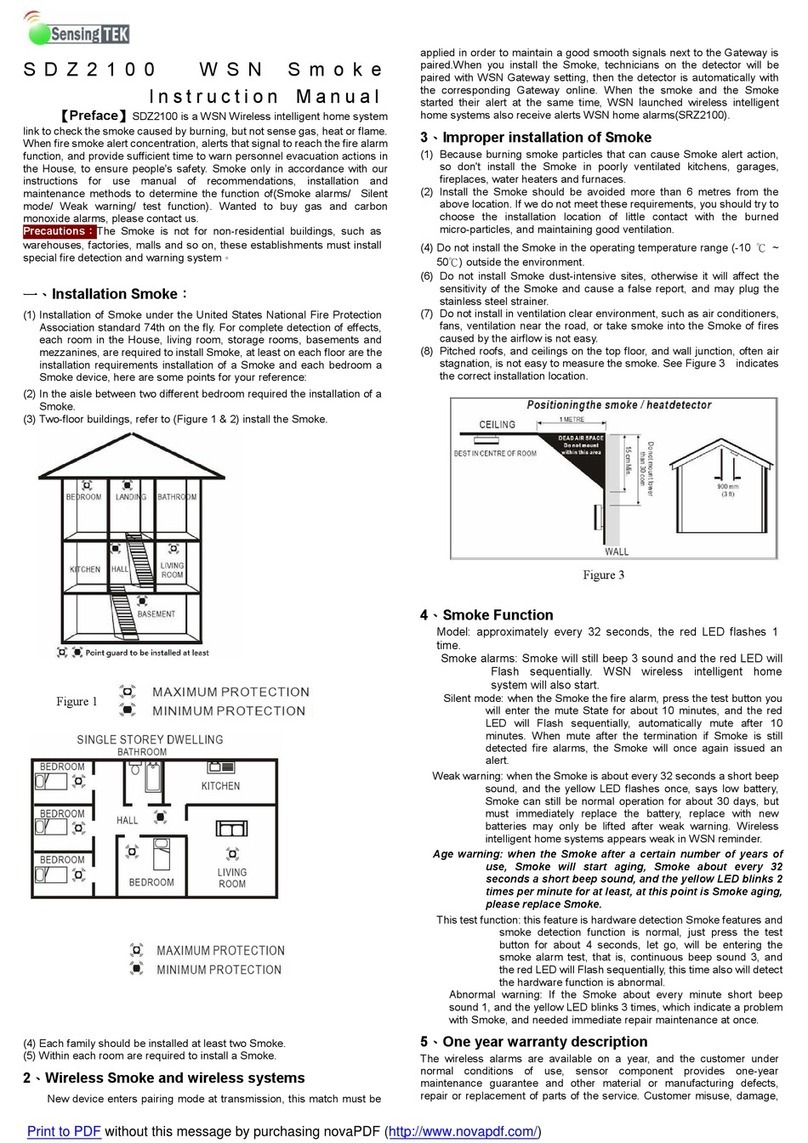
Sensing TEK
Sensing TEK SDZ2100 WSN Smoke instruction manual
